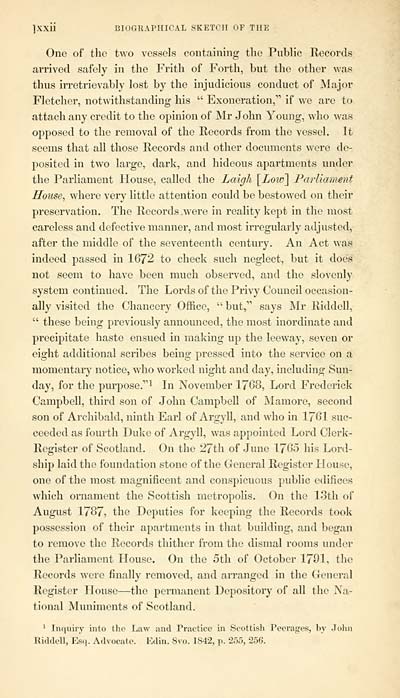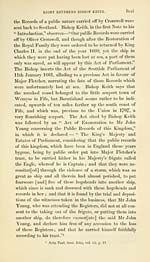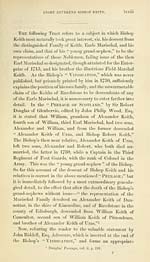Spottiswoode Society > History of the affairs of the Church and State of Scotland from the beginning of the reformation to the year 1568 > Volume 1
(80) Page lxxii
Download files
Complete book:
Individual page:
Thumbnail gallery: Grid view | List view

]XX11 BIOGRAPHICAL SKETCH OF THE
One of the two vessels containing the Public Records
arrived safely in the Frith of Forth, but the other was
thus irretrievably lost by the injudicious conduct of Major
Fletcher, notwithstanding his " Exoneration, 1 '' if we are to
attach any credit to the opinion of Mr John Young, who was
opposed to the removal of the Records from the vessel. It
seems that all those Records and other documents were de-
posited in two large, dark, and hideous apartments under
the Parliament House, called the Laigh \Low\ Parliament
House, where very little attention could be bestowed on their
preservation. The Records were in reality kept in the most
careless and defective manner, and most irregularly adjusted,
after the middle of the seventeenth century. An Act was
indeed passed in 1672 to check such neglect, but it does
not seem to have been much observed, and the slovenly
system continued. The Lords of the Privy Council occasion-
ally visited the Chancery Office, " but," says Mr Riddell,
" these being previously announced, the most inordinate and
precipitate haste ensued in making up the leeway, seven or
eight additional scribes being pressed into the service on a
momentary notice, who worked night and day, including Sun-
day, for the purpose.'''' 1 In November 1768, Lord Frederick
Campbell, third son of John Campbell of Mamore, second
son of Archibald, ninth Earl of Argyll, and who in 1701 suc-
ceeded as fourth Duke of Argyll, was appointed Lord Clerk-
Register of Scotland. On the 27th of June 1765 his Lord-
ship laid the foundation stone of the General Register House,
one of the most magnificent and conspicuous public edifices
which ornament the Scottish metropolis. On the 13th of
August 1787, the Deputies for keeping the Records took
possession of their apartments in that building, and began
to remove the Records thither from the dismal rooms under
the Parliament House. On the 5th of October 1701, the
Records were finally removed, and arranged in the General
Register House — the permanent Depository of all the Na-
tional Muniments of Scotland.
1 Inquiry into the Law and Practice in Scottish Peerages, by John
Riddell, Esq. Advocate. Edin. Svo. 1842, p. 255, 256.
One of the two vessels containing the Public Records
arrived safely in the Frith of Forth, but the other was
thus irretrievably lost by the injudicious conduct of Major
Fletcher, notwithstanding his " Exoneration, 1 '' if we are to
attach any credit to the opinion of Mr John Young, who was
opposed to the removal of the Records from the vessel. It
seems that all those Records and other documents were de-
posited in two large, dark, and hideous apartments under
the Parliament House, called the Laigh \Low\ Parliament
House, where very little attention could be bestowed on their
preservation. The Records were in reality kept in the most
careless and defective manner, and most irregularly adjusted,
after the middle of the seventeenth century. An Act was
indeed passed in 1672 to check such neglect, but it does
not seem to have been much observed, and the slovenly
system continued. The Lords of the Privy Council occasion-
ally visited the Chancery Office, " but," says Mr Riddell,
" these being previously announced, the most inordinate and
precipitate haste ensued in making up the leeway, seven or
eight additional scribes being pressed into the service on a
momentary notice, who worked night and day, including Sun-
day, for the purpose.'''' 1 In November 1768, Lord Frederick
Campbell, third son of John Campbell of Mamore, second
son of Archibald, ninth Earl of Argyll, and who in 1701 suc-
ceeded as fourth Duke of Argyll, was appointed Lord Clerk-
Register of Scotland. On the 27th of June 1765 his Lord-
ship laid the foundation stone of the General Register House,
one of the most magnificent and conspicuous public edifices
which ornament the Scottish metropolis. On the 13th of
August 1787, the Deputies for keeping the Records took
possession of their apartments in that building, and began
to remove the Records thither from the dismal rooms under
the Parliament House. On the 5th of October 1701, the
Records were finally removed, and arranged in the General
Register House — the permanent Depository of all the Na-
tional Muniments of Scotland.
1 Inquiry into the Law and Practice in Scottish Peerages, by John
Riddell, Esq. Advocate. Edin. Svo. 1842, p. 255, 256.
Set display mode to: Large image | Transcription
Images and transcriptions on this page, including medium image downloads, may be used under the Creative Commons Attribution 4.0 International Licence unless otherwise stated. ![]()
| Permanent URL | https://digital.nls.uk/79597748 |
|---|
| Description | Volume I. |
|---|---|
| Attribution and copyright: |
|

